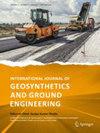三轴条件下土-土工合成物相互作用:抗剪强度增加及试件尺寸的影响
IF 2.3
Q2 ENGINEERING, GEOLOGICAL
International Journal of Geosynthetics and Ground Engineering
Pub Date : 2023-11-14
DOI:10.1007/s40891-023-00502-6
引用次数: 0
摘要
摘要土工合成材料是一种可扩展的增强材料,用于提高土体的工程性能。应力从土到钢筋的传递是通过土-土工合成物相互作用实现的。从文献的建议,以评估在三轴条件下加筋土的抗剪强度使用三种不同的方法。这些包括分析加筋土:(i)作为一种均质复合材料(方法a), (ii)作为两种不同的材料(方法B),或(iii)作为具有相同基本抗剪强度的土,钢筋的作用表现为额外的侧向或围应力(方法C)。在本文中,使用土工合成材料加固土的三轴试验数据和不同尺寸(直径70和150 mm)的试样来评估抗剪强度的变化并进行统计分析。用文献中的公式分析了加筋土和土工合成材料界面抗剪强度的增加。使用协方差分析(ANCOVA)评估不同尺寸标本的三轴结果之间的差异。当回归模型的联合项不具有统计学意义时,使用不同试样尺寸的特征来生成土破坏包络层。因此,提出了一种新的方法来获得不同试样尺寸的失效包络线。本文章由计算机程序翻译,如有差异,请以英文原文为准。
Soil–Geosynthetic Interaction Under Triaxial Conditions: Shear Strength Increase and Influence of the Specimen Dimensions
Abstract Geosynthetics are extensible reinforcements used to enhance the engineering performance of a soil. The transfer of stresses from the soil to the reinforcement is achieved through soil–geosynthetic interaction. The proposals from the literature to assess the shear strength of the reinforced soil under triaxial conditions use three different approaches. These involve analysing the reinforced soil: (i) as a homogeneous composite material (Approach A), (ii) as two different materials (Approach B), or (iii) as soil having the same fundamental shear strength, with the effect of the reinforcement represented as an additional lateral or confining stress (Approach C). In this paper, triaxial tests data of a soil reinforced with a geosynthetic, and specimens with different dimensions (diameters 70 and 150 mm) were used to assess changes in shear strength and to carry out a statistical analysis. The increases in shear strength of the reinforced soil and of the soil–geosynthetic interface were analysed using equations from the literature. The difference between the triaxial results obtained from specimens of different sizes was assessed using an Analysis of Covariance (ANCOVA). When the joint term of the regression model was not statistically significant, the characterisation from different specimen sizes was used to generate soil failure envelopes. Thus, a new methodology to obtain a failure envelope with different specimen sizes is presented.
求助全文
通过发布文献求助,成功后即可免费获取论文全文。
去求助
来源期刊

International Journal of Geosynthetics and Ground Engineering
ENGINEERING, GEOLOGICAL-
CiteScore
4.20
自引率
17.20%
发文量
68
 求助内容:
求助内容: 应助结果提醒方式:
应助结果提醒方式:


